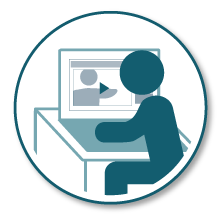Teaching Online
Explore the pathways to teaching online at Seattle U.
Interested in Teaching Online?

Good teaching is good teaching, whether it happens in courses that are face-to-face, web-facilitated, hybrid or fully online. The difference in teaching online is that digital components require careful planning, and fully-online courses take a considerable amount of time to produce the kind of high-touch student learning experience we expect at Seattle University. Below are some ways you can explore teaching online through CDLI.
Pathways for Teaching Online
Online Program Design
Explore how the Center for Digital Learning & Innovation supports the development of high-quality, mission-aligned online programs at Seattle University.
/0x0:460x280/prod01/channel_34/media/seattle-university/center-for-digital-learning-and-innovation/images/CDLI-approved-460X280-rectangle.png)
Learn About Online Course Development and Review
All online courses (synchronous or asynchronous) must pass CDLI review in order to be offered beginning in Fall Quarter 2023. If you're interested in developing a new online course, start here.
/0x0:460x280/prod01/channel_34/media/seattle-university/center-for-digital-learning-and-innovation/images/Online-Course-Development--Review-460X280-rectangle.png)
Course Design Program
If you plan to design a fully online or hybrid course, consider joining this community of practice that meets once a week for one quarter.
/0x0:460x280/prod01/channel_34/media/seattle-university/center-for-digital-learning-and-innovation/images/Course-Design-Program-460X280-rectangle.png)
Course Facilitation
Faculty are sometimes assigned to teach a fully online course that was designed and certified by another instructor. We call this process “course facilitation.” Teaching an online course built by another faculty member can sometimes require a bit of training and orientation, so CDLI is here to help.
/0x0:460x280/prod01/channel_34/media/seattle-university/center-for-digital-learning-and-innovation/images/Course-Facilitation-460X280-rectangle.png)
Calendar of Upcoming Events
If you would just like to learn a little more about teaching online, we have a variety of workshops and consultations that happen frequently, virtually or in our lab.
/0x0:460x280/prod01/channel_34/media/seattle-university/center-for-digital-learning-and-innovation/images/Calendar-460X280-rectangle.png)
Course Definitions
 Web-Facilitated Courses
Web-Facilitated Courses
A traditional face-to-face course where the instructor uses technology to enhance the instructional experience.
 Hybrid Course
Hybrid Course
A course where any of the traditional face-to-face class time is replaced by online learning activities. A hybrid course is also known as a “blended course.”
 Online course
Online course
All course activity is done online. There are no required face-to-face sessions within the course and no requirements for on-campus activity.
Most online course activity and coursework are completed asynchronously (no requirement to be online at the same time), although there may be occasional synchronous meetings but they do not necessitate that students be on campus. Online courses cannot be self-paced, independent study courses and should instead provide rich learning experiences with a high number of instructor-student and student-student interactions.